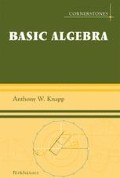Abstract
This chapter continues the development of group theory begun in Chapter IV, the main topics being the use of generators and relations, representation theory for finite groups, and group extensions. Representation theory uses linear algebra and inner-product spaces in an essential way, and a structure-theory theorem for finite groups is obtained as a consequence. Group extensions introduce the subject of cohomology of groups.
Sections 1–3 concern generators and relations. The context for generators and relations is that of a free group on the set of generators, and the relations indicate passage to a quotient of this free group by a normal subgroup. Section 1 constructs free groups in terms of words built from an alphabet and shows that free groups are characterized by a certain universal mapping property. This universal mapping property implies that any group may be defined by generators and relations. Computations with free groups are aided by the fact that two reduced words yield the same element of a free group if and only if the reduced words are identical. Section 2 obtains the Nielsen-Schreier Theorem that subgroups of free groups are free. Section 3 enlarges the construction of free groups to the notion of the free product of an arbitrary set of groups. Free product is what coproduct is for the category of groups; free groups themselves may be regarded as free products of copies of the integers.
Sections 4–5 introduce representation theory for finite groups and give an example of an important application whose statement lies outside representation theory. Section 4 contains various results giving an analysis of the space C(G, ?) of all complex-valued functions on a finite group G. In this analysis those functions that are constant on conjugacy classes are shown to be linear combinations of the characters of the irreducible representations. Section 5 proves Burnside’s Theorem as an application of this theory—that any finite group of order paqb with p and q prime and with a+b > 1 has a nontrivial normal subgroup.
Section 6 introduces cohomology of groups in connection with group extensions. If N is to be a normal subgroup of G and Q is to be isomorphic to G/N, the first question is to parametrize the possibilities for G up to isomorphism. A second question is to parametrize the possibilities for G if G is to be a semidirect product of N and Q.
Access this chapter
Tax calculation will be finalised at checkout
Purchases are for personal use only
Preview
Unable to display preview. Download preview PDF.
Author information
Authors and Affiliations
Corresponding author
Rights and permissions
Copyright information
© 2006 Anthony W. Knapp
About this chapter
Cite this chapter
Knapp, A.W. (2006). Advanced Group Theory. In: Basic Algebra. Cornerstones. Birkhäuser, Boston, MA. https://doi.org/10.1007/978-0-8176-4529-8_7
Download citation
DOI: https://doi.org/10.1007/978-0-8176-4529-8_7
Publisher Name: Birkhäuser, Boston, MA
Print ISBN: 978-0-8176-3248-9
Online ISBN: 978-0-8176-4529-8
eBook Packages: Mathematics and StatisticsMathematics and Statistics (R0)

